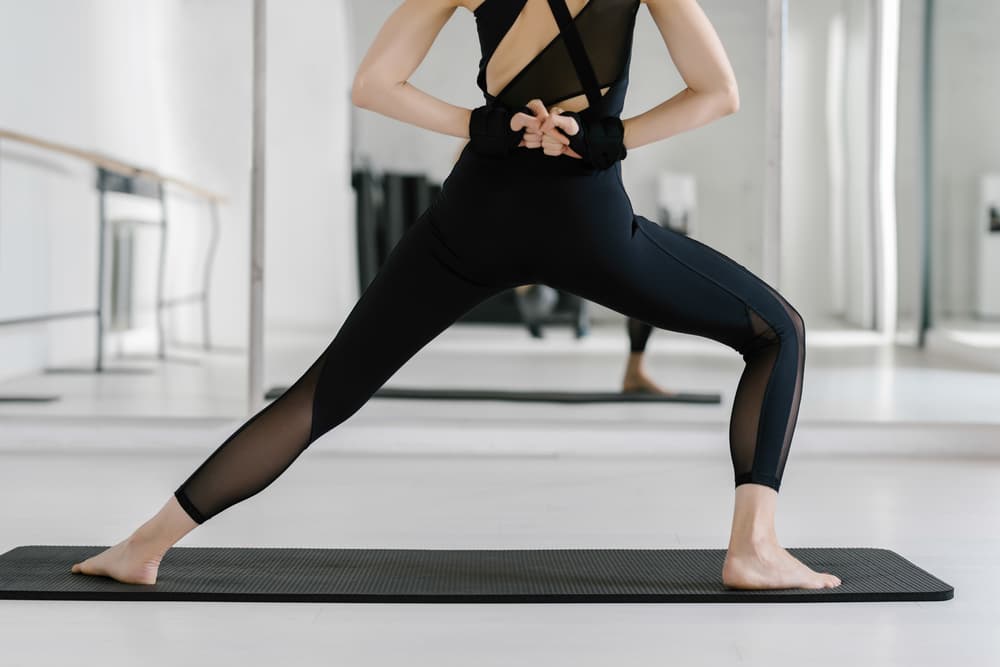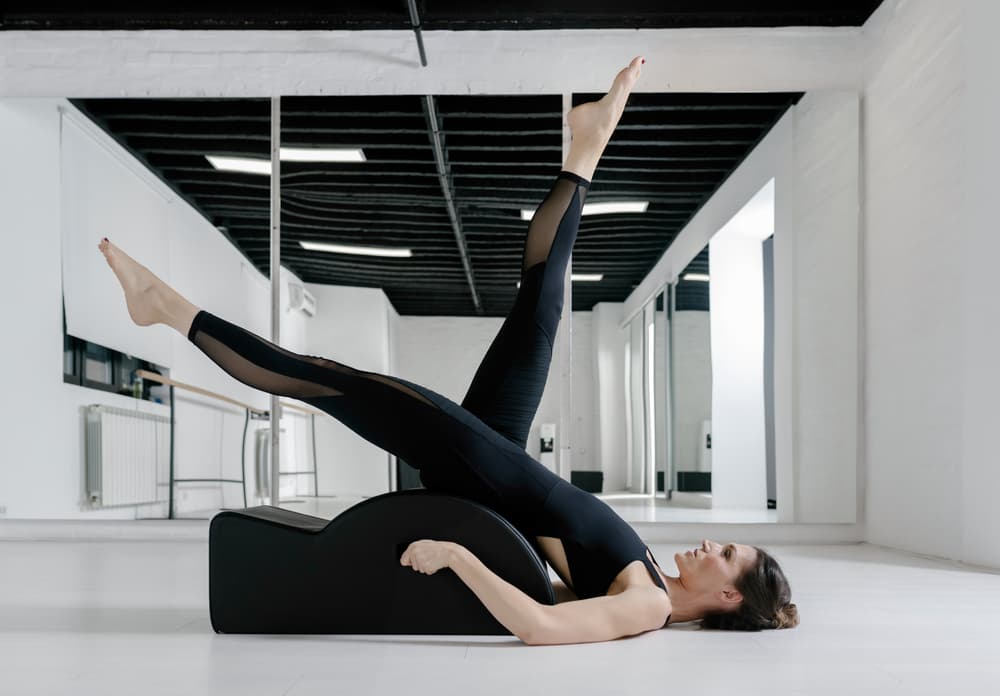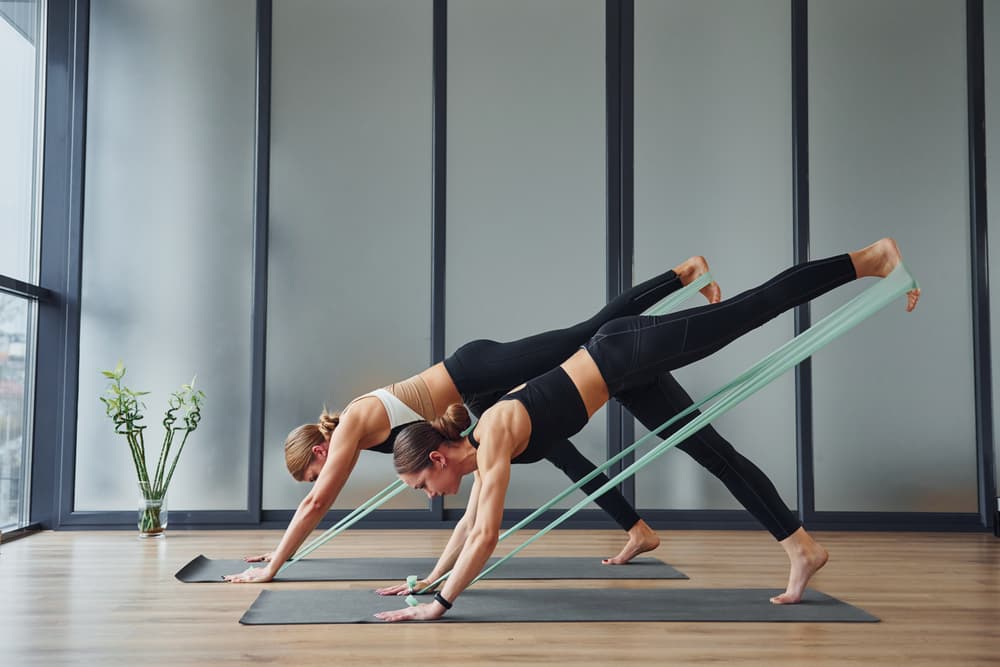Pilates is worth adding to any weight loss program. It helps burn calories and gives you other benefits like improved posture, flexibility, and core strength.
But if you are after faster weight loss, doing exclusive Pilates may not be the most effective strategy.
Let’s learn more about how Pilates affects the body.
That way, we can understand better why this exercise needs tweaking and reinforcement for optimum weight loss results.
What is Pilates?
Pilates is a low-impact workout developed by Joseph Pilates in the early 20th century.
This exercise mainly builds and tones the muscles through controlled body movements.
It also aims to develop proper postural alignment and counter muscular imbalances.
And this explains why Pilates was first popular in the dance industry and used for body conditioning.
Today, even non-dancers can enjoy a Pilates session at home or in studios.
You can also do Pilates with or without equipment.
Can Pilates Help with Weight Loss?
As more people started doing Pilates, the interest in its role in weight loss has grown as well.
But given that it’s a slow and low-impact exercise, can it help you lose weight?
The quick answer is yes, Pilates aids in weight loss, and there are several reasons how:
- It burns a good number of calories. According to a study by the American Council on Exercise (ACE), a 68-kg individual burns about 175 calories in a 50-minute beginner Pilates mat class. And an advanced routine burns around 254 calories.
- It improves your lean muscle mass. Your muscles stretch and elongate as you perform various Pilates moves. As a result, you redistribute the weight and sculpt your body, giving you a toned and slimmer physique. People often call this the Pilates effect.
- It boosts your metabolism. Working the muscles during Pilates leads to a higher metabolic rate. When metabolism increases, your body also starts burning calories efficiently.
- It strengthens your mind-body connection. This effect may not apply to others, but regular Pilates makes you more mindful. Specifically, you start eating better and opting for healthier choices.
- It reduces stress. Too many frustrations often lead to stress eating. But a calmer mind and body through Pilates can prevent this from happening. Moreover, like other exercises, Pilates stimulates feel-good hormones, helping you manage daily stress better.

What do studies say?
There are some peer-reviewed studies on the relationship of Pilates with weight loss.
But the findings are somewhat mixed and inconclusive.
For instance, a study in 2015 found that Pilates can boost the upper body, lower body, and abdominal muscle strength among postmenopausal women.
However, it does not affect body composition.
In 2017, researchers concluded that eight weeks of Pilates among overweight or obese women led to positive changes.
These include weight loss, lower body mass index (BMI), toned waist, and reduced abdomen and hip circumference.
But despite these, they found no significant change in lean body mass.
A more recent study in 2021 had similar results.
Specifically, the researchers found that Pilates can reduce weight, BMI and body fat percentage in overweight or obese individuals.
Yet, they also found that Pilates did not significantly affect lean body mass and waist circumference.
While experts have yet to come up with more definite results, current studies also didn’t cite any downside of Pilates on weight loss.
How Can You Maximise Pilates for Weight Loss?
Based on the facts and research findings above, it is safe to say that Pilates is not a high-calorie-burning exercise.
Still, it has a good weight loss potential. So, continue doing and mastering Pilates.
But consider making a few changes and applying these tips to optimise its weight loss effects.
1. Boost your Pilates intensity
Increasing your workout intensity is one of the most effective methods to maximise caloric burn. And this fitness fact also applies to Pilates.
As you work out harder, your heart also beats faster. A higher heart rate makes you burn more calories.
So, instead of sticking to slow, controlled moves, shift to advanced Pilates exercises like the hip twist, swan dive, jackknife, or boomerang.
You can also increase your Pilates intensity by shortening your rest time between exercises.
Alternatively, you can do less challenging Pilates moves with higher body engagement or exertion.
Make every move precise, stretch your body as much as possible, and avoid Pilates workout mistakes.

2. Make your Pilates sessions longer and more frequent
Exercise duration is another important ingredient in successful weight loss that you can apply to your Pilates routine.
Simply put, the more you spend time doing Pilates, the more calories you burn during your workouts.
But how long and frequent should your Pilates sessions be?
A 30-minute session two to three times weekly is a good start if you are at the beginner level.
Then, allocate the remaining days of the week for other cardio-based exercises and rest.
Later, you can create a workout schedule based on the 150-minute physical activity requirement.
Make sure to stick to your workout routine and continue progressing to more advanced Pilates sessions.
Combining exercise intensity, duration, and consistency is a very effective strategy for losing weight.
3. Complement Pilates with other forms of exercise or equipment
Probably my favourite technique when working out to lose weight is performing variations.
This one is all about jazzing up familiar moves with either added actions or extra equipment.
And you can do this in Pilates, too. For example, if you love doing mat Pilates, level it up with a resistance band, exercise ball, light dumbbells or the Pilates ring.
Moving your mat workouts to the Pilates reformer is also a very effective weight-loss strategy.
This sliding platform has adjustable resistance springs and accessories to boost the intensity of your exercises.
You can even combine cardio moves with Pilates if you like.
Have you heard of Piloxing? It’s a fun combination of Pilates, boxing, and dance with upbeat music!
Alternatively, you can do separate days for Pilates and cardio workouts.
But I suggest making them complementary to ensure balance. Here are a few ideas:
- Swimming. This one is an excellent complementary exercise if you are doing Pilates to lose weight and reduce joint pains. Research also shows that swimming improves mood and is good for mental health, making it a suitable match with Pilates.
- Weight training. Pilates focuses on toning your muscles and strengthening your core. Adding weight training to the mix should amplify these benefits by increasing muscle mass.
- Cycling. Pilates and cycling are low-impact exercises that increase muscle tone, enhance flexibility, and improve posture. Exercise bike workouts are also ideal for sustainable weight loss.
- HIIT. They say opposites attract, and combining Pilates with high-intensity interval training (HIIT) is a perfect example. While Pilates works on smaller muscles, you can do HIIT on the treadmill, stationary bike, or rowing machine to target large muscle groups. It’s the best combo to boost your calorie burn, too.

Conclusion
Weight loss effects may not be the best feature of Pilates. But that doesn’t mean you should scrap it from your workout plan.
Keep doing Pilates if this is your preferred physical activity.
This exercise may not burn as many calories or give results as quickly.
But regular Pilates leads to other benefits that make you feel and look good.
And you can easily enhance your Pilates routine through higher intensity or longer sessions for better fitness outcomes.
Also, adding a Pilates reformer machine to your home gym should help you achieve your weight loss goals.
Related Questions
1. Is Pilates better than weight training?
Pilates and weight training focus on muscle development. But the choice between the two depends on your goals. For instance, choose Pilates to improve your lean muscle mass and flexibility. But if your goal is to boost muscle power, strength and size, weight training is a better option.
2. Is Pilates functional training?
Pilates is a form of functional training as it trains the body for enhanced functionality, flexibility, and mobility. Its exercises mimic real-life movements, allowing you to perform day-to-day activities better.
- Foldable vs Traditional Reformers: Which One’s Right for You? - 2 July 2025
- Elliptical Cross Trainer vs Exercise Bike: Which is Better? - 24 June 2025
- How Do the Different Massage Gun Attachments Work? - 23 June 2025
